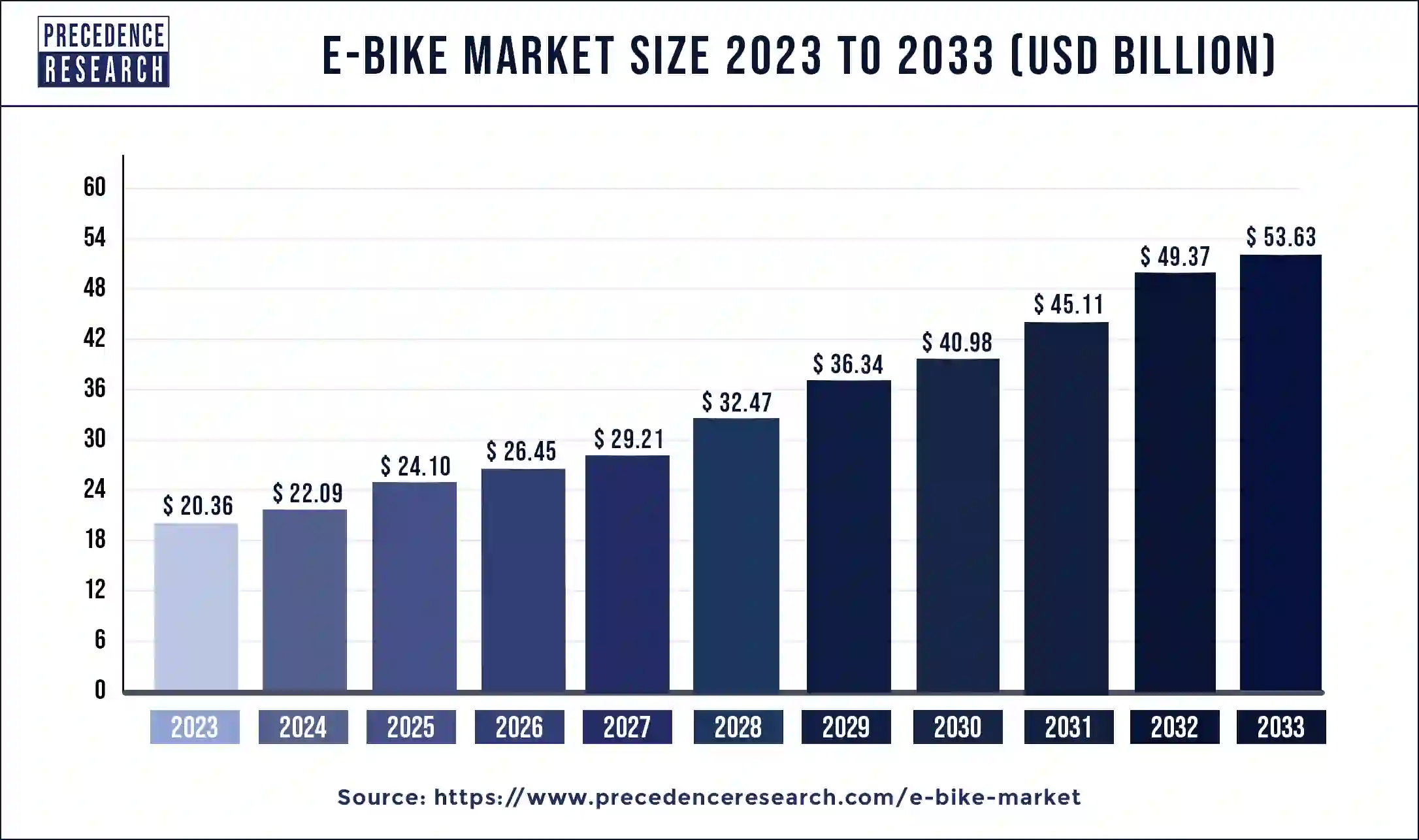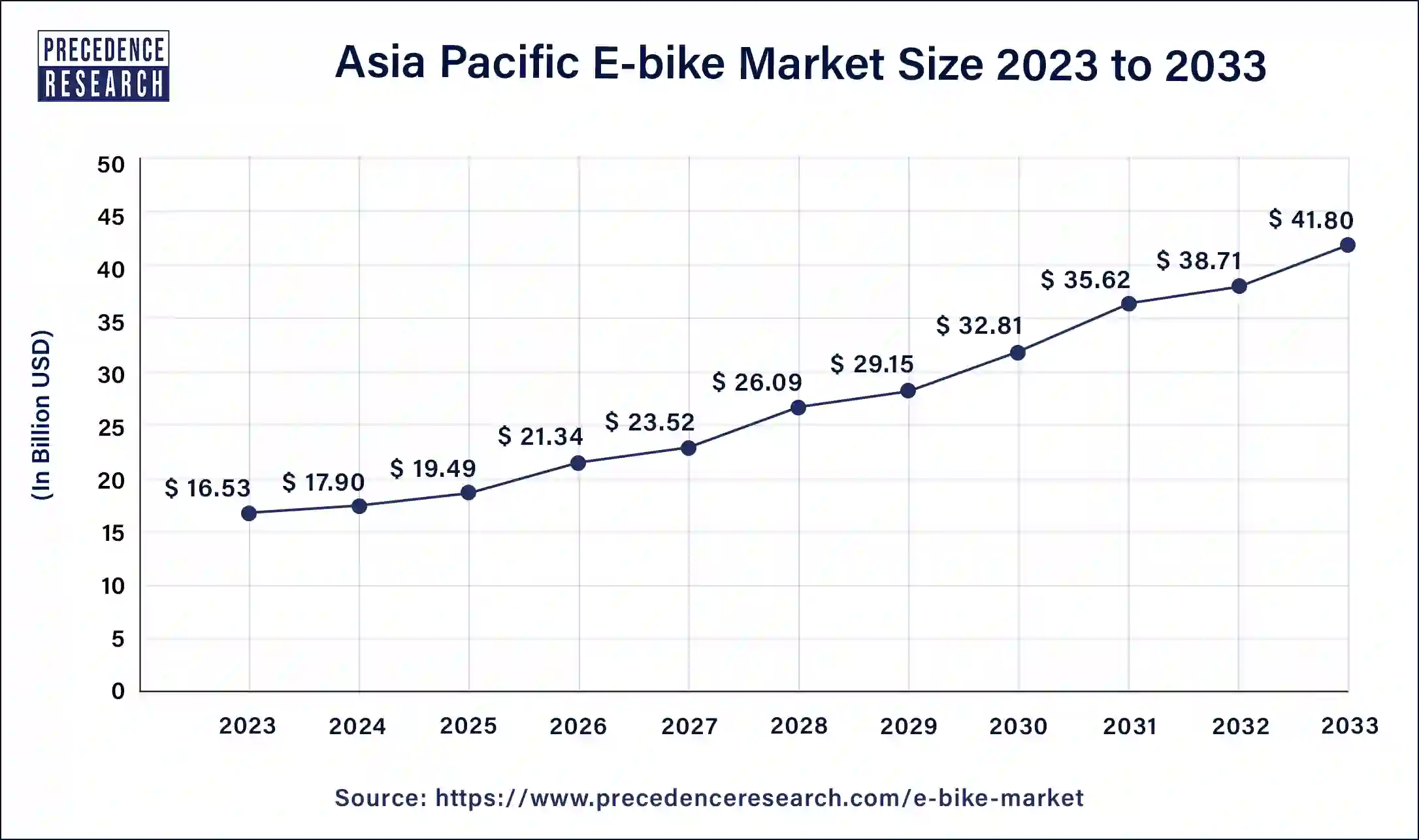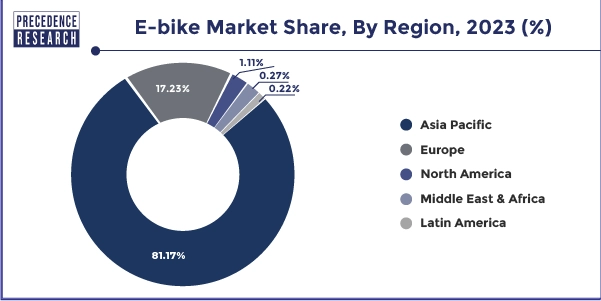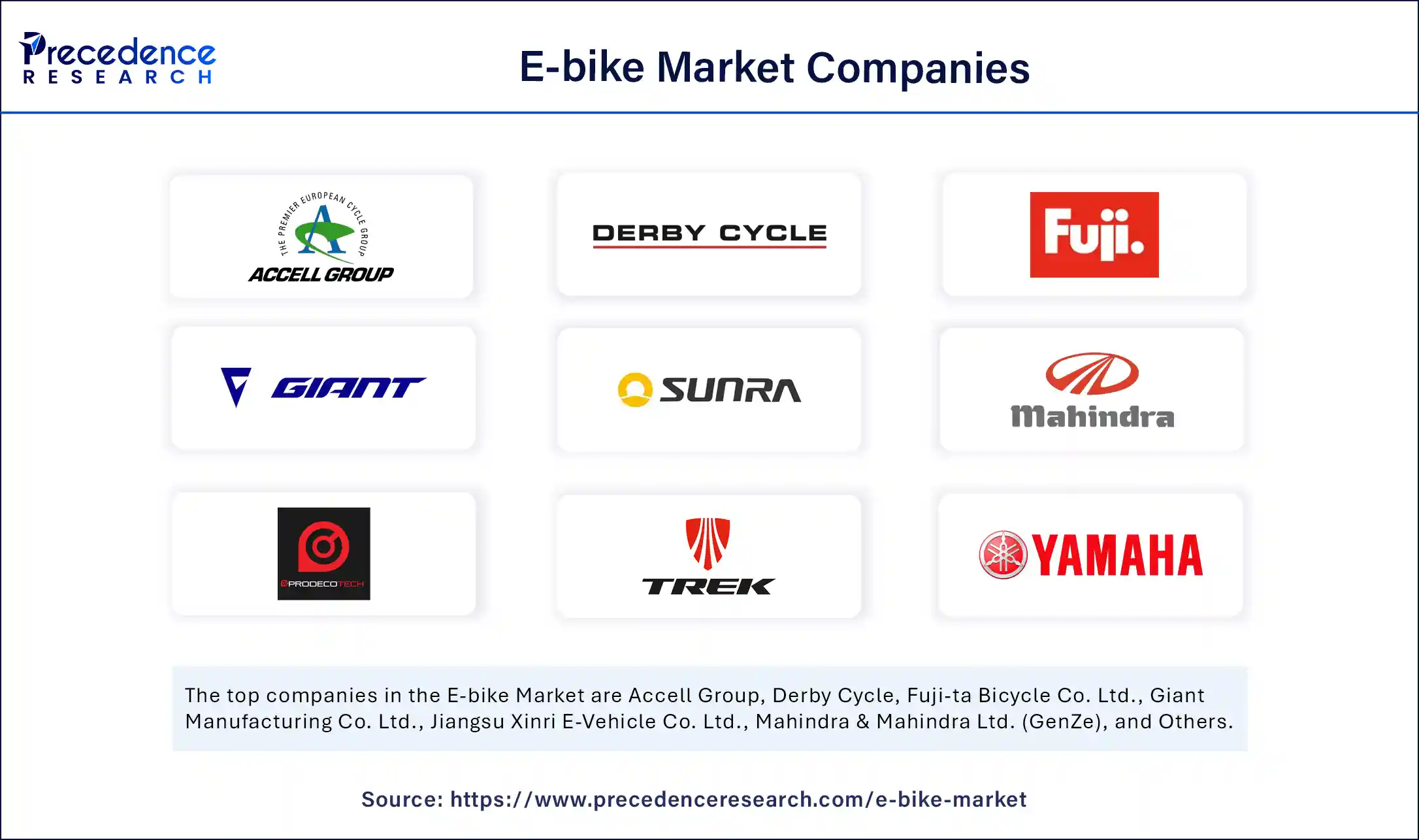What is the E-bike Market Size?
The global e-bike market size is calculated at USD 68.34 billion in 2025 and is predicted to increase from USD 75.41 billion in 2026 to approximately USD 180.25 billion by 2035, expanding at a CAGR of 10.18% from 2026 to 2035.

Key Takeaways
- In terms of revenue, the global e-bike market was valued at USD 68.34 billion in 2025.
- It is projected to reach USD 180.25 billion by 2035.
- The market is expected to grow at a CAGR of 10.18% from 2025 to 2035.
- By motor type, the hub motor segment captured the biggest market share in 2025.
- By Application, the city/urban segment contributed the highest market share in 2025.
- By Mode, the paddle assist segment accounted for a significant market share in 2025.
- By Battery, the Lithium-ion battery segment led the market in 2025.
- By Class, the class 1 segment generated the major market share in 2025.
- By Speed, Up to 25 km/h segment held the largest market share in 2025.
Summary speeding the E-bike Market
Electric bikes offer huge growth potential as they endure to gain traction in Europe as a more ecological means of transport. Sales in the U.S. is predicted to lift as associated regulations will take shape. Along with healthy European and U.S. markets and expected rebound in sales in China is projected to offer a more stable environment for the e-bike market place during years to come.
Electric bicycles (e-bikes) are similar to human-powered bicycles with small electric motor that assist or substitute the pedalling efforts. Some models of e-bike offer throttle based motor activation and some offer pedal-assist bike. Complex model with advanced electric motor and optional throttle activation are also available in the market. There are three classes of e-bike available in the market that include Class 1, Class 2, and Class 3. They are generally categorized under two speed ranges that are up to 25 kmph and second is 25-45 kmph.
Main parts of an e-bike include battery pack, electric motor, controller, throttle, PAS & torque sensor, e-brakes, display, torque arms, and hall sensors. Battery pack and electric motor used in an e-bike constitute for majority of e-bike prices. Some of the advantages associated with the application of e-bike are low operating cost, a combined advantage for both bicycle and motorbike, ecological means of transport, good for exercise.
Market Outlook
- Sustainability trends
The sustainability trends involve the implementation of recycled materials in manufacturing, improved battery technology (focusing on durability) and unifying intelligent tech for superior durability and efficiency. The E-bike market supports sustainability by reducing the carbon emissions footprint and displacing car trips. The other major trend is infrastructure support and government incentives. - Start-up Ecosystem
The start-up ecosystem includes different business models from manufacturing operations, investor support, technology innovation, assembly, to rental services and infrastructure development. The major areas covering this ecosystem involve generating new engine systems, establishing affordable and sustainable models and charging infrastructure.
MarketScope
| Report Coverage | Details |
| Market Size by 2035 | USD 180.25 Billion |
| Market Size in 2025 | USD 68.34 Billion |
| Market Size in 2026 | USD 75.41Billion |
| Growth Rate from 2026 to 2035 | CAGR of 10.18% |
| Largest Market | Asia Pacific |
| Fastest Growing Market | Middle East & Africa |
| Base Year | 2025 |
| Forecast Period | 2026 to 2035 |
| Segments Covered | Class, Speed,Battery Type, Motor Type, Mode, Application, Region |
| Regions Covered | North America, Europe, Asia-Pacific, Latin America and Middle East & Africa |
Some of the major trends and growth factors that govern the market growth of e-bike are discussed below:
- Growing popularity of e-MTB: With the increase in global demand for cycling across the world during past 2 years, one area that has witnessed significant surge in popularity is mountain biking. As per an analysis, mountain biking and trekking market expected to grow at an accelerating rate of 10% during the upcoming years ranging from 2020-2027. Stupendous rise in adventurous sports and tourism likely to propel the market growth for e-MTB.
- Growing preference for bicycles as an eco-friendly vehicle: With increasing necessity of environment-friendly transportation, popularity of bicycles is booming across various parts of the world. This is mainly because of numerous benefits offered by the cycling such as reduced CO2 emission, reduced air pollution, reduced noise pollution from other transportation modes, saves fuel cost, improves public health, less congestion on roads, and also saves construction and maintenance cost of road infrastructure.
- Increasing Popularity of Mid-drive Motors: Hub motors are lighter in weight, simple in construction, and inexpensive to the manufacturers because of which it is the most commonly found motors in the e-bike. However, significant number of advantages offered by the mid-drive motors over hub motors expected to drive their demand overt the forthcoming years. Mid-drive motors offer higher torque and performance compared to traditional hub motors as it drives the crank despite of wheel; hence, multiply its power and allow to take more benefits from the gear system. In respect to maintenance too, mid-drive motors are easier to be service and maintained compared to hub motors. They can be simple removed from the e-bike by replacing nut bolts. Further, they are placed at the center of gravity of the e-bike that helps in better handling of the e-bike by better distribution of the bike weight. Thus, the aforementioned benefits of the mid-drive motor make them more popular compared to hub motors among e-bike manufacturers and the consumers.
E-Bike Market Dynamics
Drivers
Government support to reduce CO2 emissions
The United States federal government aims to make half of the new vehicles sales in 2030 to be zero-emission vehicles. They are also planning to introduce a network of 5,00,000 chargers for the convenience of Americans. The demand for e-bikes is experiencing a major surge owing to the surging initiatives taken by the governments of various countries. Rising awareness regarding the health hazards associated with the usage of traditional fuel-based vehicles is proliferating the growth of the market. Moreover, growing environmental concerns due to the extensive usage of fossil fuel is leading to a surge in government initiatives. Moreover, the government is focusing on the development of electric scooters, motorcycles, and bicycles as they are more reliable and help reduce carbon footprints.
Rising cost of fuels
The prices of fuel rose significantly nearly 5 times i.e. 57% faster than overall consumer prices in India between January 2021 and August 2022. Increasing prices of fuels are shifting the demand toward the electric bike. The reason behind the rise in fuel prices is the increase in crude oil's cost which is in the hands of the Organisation of the Petroleum Exporting(OPEC) countries. Moreover, multiple governments are working on developing the charging infrastructure required for adopting electric bicycles. Federations are providing total cost benefits with the help of incentives, programs, and subsidies. People are more likely to use electric bikes because they are environmentally friendly and easy to use. As a result, it is anticipated that a rise in gasoline prices will encourage people to use electric bikes, leading to the expansion of the e-bike market.
Restraints
High cost
The high cost associated with the purchase of e-bikes is restraining the growth of the market. The additional cost of battery and electric motor makes it less accessible for budget-conscious consumers. Traditional bikes, bicycles and scooters are comparatively cheaper than electric scooters which makes it an attractive option. Moreover, the usage of lithium-ion batteries incurs additional maximum cost which is further limiting the growth of the industry.
Lack of charging infrastructure
The unavailability of adequate charging infrastructure is one of the biggest challenges in the market. E-bikes rely on rechargeable batteries for power, lack of reliable or accessible power solutions makes it not so attractive mode of transportation. Without adequate infrastructure, e-bike riders are restricted to the range of their batteries, which may limit the e-bike's utility for daily commuting, long-distance trips, or delivery services. However, the government is taking various initiatives to develop the charging infrastructure in various regions.
Opportunity
Rising trend of connected e-bikes
These smart e-bikes can transmit important information about their usage and state. Certain linked bikes can accept commands as well as other information. Networked e-bike systems enable data collection and processing. Nowadays, businesses are stepping forward to find integrated solutions. Therefore, the trend of e-bikes would allow the market to expand in the upcoming period.
Segment Insights
Class Insights
Class 1 e-bike capture the largest market revenue share 2024 and expected to maintain its dominance during the forthcoming years as well. The rising demand for pedelecs because of their health assistance along with power assistance within the range of 25 kph that does not have any regulation on its driving likely to propel the growth for class 1 e-bikes.
In Class 2 e-bikes Segment includes both pedal-assist functionality and a throttle that enables motor activation without pedaling, are known for its ease of use. They are particularly appealing to riders who may have physical limitations or prefer a more effortless riding experience. Class 2 e-bikes are commonly used for commuting and leisure riding, offering convenience and flexibility. The availability and demand for Class 2 e-bikes might depend on regional regulations, as some areas may have restrictions on throttle-operated e-bikes. However, in regions where throttle-assist e-bikes are allowed, they can be a popular choice for riders seeking a simple and accessible mode of transportation.
Class 3 e-bikes are estimated to dominate in coming years, The Class 3 E-bikes often referred to as speed peddles, provide pedal-assist functionality with a higher maximum speed of 28 mph (45 km/h). These e-bikes cater to riders who desire a faster alternative to traditional bicycles, making them suitable for commuting longer distances or navigating through urban areas more swiftly. Class 3 e-bikes are commonly used for commuting purposes, as they offer the ability to reach destinations quicker while still benefiting from the assistance of the electric motor. However, the dominance of Class 3 e-bikes can be influenced by local regulations, as some regions may have restrictions or licensing requirements for higher-speed e-bikes.
Motor Type Insights
Hub motor dominated the global e-bike market with the highest revenue share in 2024 and is expected to maintain the same trend over the forecast time frame as well. The main factor driving their demand is less or minimum maintenance required as they do not exert pressure on the drivetrain and operate independently. On the other hand, mid-drive motor estimated to grow at the fastest rate over the analysis period. This is mainly because they are directly connected to the gears and cranks of the bike and thus offers higher torque and performance compared to hub motors.
Speed Insights
E-bikes with a speed limit of up to 25 km/h are often classified as low-speed electric bicycles and are commonly used for urban commuting, recreational riding, and short-distance travel. They are popular among a wide range of users, including commuters, students, and casual riders. These e-bikes benefit from relaxed regulations in many jurisdictions, making them more accessible and widely adopted.
On the other hand, e-bikes with a speed range of 25-45 km/h dominate the market share, such as speed peddles or high-speed e-bikes, are subject to more stringent regulations and may require additional licensing, registration, and safety equipment. The market for high-speed e-bikes is typically smaller due to these regulatory restrictions and the specific needs of riders who require faster speeds for longer commutes or traveling on open roads.
Battery Type Insights
The market has been divided into two types of batteries: lithium-ion (Li-ion) batteries and lead-acid batteries. In 2024, the lead-acid battery sector led the market. The segment's expansion can be due to the several advantages provided by lead-acid batteries, such as low cost and resilience. However, because these batteries are heavy and drain quickly, their use is expected to dwindle in the coming years.
From 2025 to 2034, the lithium-ion battery segment is expected to increase at a CAGR. According to a European Commission report, the price of lithium-ion batteries is expected to fall by approximately 70% by 2032. High charge density, high performance, lightweight, and high charging-discharging efficiency are expected to favor the adoption of these batteries, consequently aiding segment expansion.
Application Insights
The trekking segment dominated in 2024.E-bikes are increasingly being used for leisure and hiking purposes. Furthermore, the growing awareness of performance-based adventure, as well as a rising need for leisure activities, are likely to give rise to market growth. Trekking e-bikes and eMTBs are quite adaptable, and some of them are cutting-edge. The greatest are true all-rounders, with intelligent and friendly handling that instills confidence in the city, on bike, woodland, meadow, and gravel pathways, as well as on off-road terrain.
From 2025 to 2034, the cargo segment is expected to increase at remarkable CAGR. The increasing demand for e-bikes to transport luggage from one location to another is likely to help the segment's growth throughout the forecast period. A spike in transportation and freight activity in nations such as India and China is also predicted to fuel e-bike demand.
Component Insights
Based on components the battery segment dominates the market with highest market share. The battery is a crucial component of an e-bike, providing power to the electric motor. This segment includes various types of e-bike batteries, such as lithium-ion, nickel-metal hydride (NiMH), or lead-acid batteries. Battery capacity, voltage, and charging systems can also be considered within this segment.
On the other hand, the electric motor is responsible for providing propulsion assistance to the rider. This segment encompasses different types of electric motors used in e-bikes, including hub motors, mid-drive motors, and friction-drive motors. Motor power, efficiency, and torque characteristics can also be considered within this segment.
Market Competition and Players Analysis
The market players in the global e-bike market faces intense competition among themselves owing to significant investment in order to upgrade the performance of the e-bike and make them more comfortable for the users application. The prime motive behind such investments is to make e-bike as the preferred choice for customers against their passenger cars and other private vehicles. Some of the players have prominently invested in the advancement of the e-bike drive unit in order to enhance its performance.
Regional Insights
What is the Asia Pacific E-bike Market Size?
The Asia Pacific e-bike market size was valued at USD 40.32 billion in 2025 and is expected to be worth around USD 107.46 billion by 2034 with a CAGR of 10.30% from 2026 to 2035.

Leading Market:The Asia Pacific emerged as the global leader in the e-bike industry owing to prominent growth in the production and demand volume of e-bikes in the region. Approximately 81% of the market revenue in concentrated in the region with China as the front-runner in the region accounting for more than 90% of the global e-bike production concentrated in the country. As per a data published by the China Motor World, total production of e-bike in China accounted more than 30 million in the year 2018. This anticipated to further drives the market growth for e-bike in the region.

Fastest Growing Market:The Middle East & Africa market in e-bike industry is still at its early adoption phase and reported the fastest growth during the forthcoming years. The prime factor contributing to the significant growth of the region is rapid development in infrastructure formicromobility in the region. Further, in the recent past the region seeks attractive demand for the bike sharing platforms. For instance, in December 2019, PBSC Urban Solutions, a Canada based smart bike-share solution provider announced to enter into a partnership agreement with Careeem, a leading ride-hailing company based in the Middle East, to launch e-bike sharing service in UAE. As per the agreement, the company will provide 3,500 e-bikes and 350 smart stations in the country. Hence, these initiatives in the region expected to bolster the demand for e-bikes in the region.
North America E-bike Market Trends
North America is witnessing a notable amount of growth rate and is expected to grow even more in the forecast period. This growth is fueled by the increasing environmental consciousness and rising government incentives that aim to promote sustainable transportation. Urban commuting and recreational use are key factors for the region, with a strong emphasis on e-mountain bikes and city bikes. The region also benefits from advancing cycling infrastructure and the rising adoption of e-bikes among fitness and adventure enthusiasts.
The demand is mostly concentrated in urban areas, where e-bikes are increasingly seen as popular choices compared to traditional commuting methods. State-level subsidies and tax credits are further accelerating market adoption, especially in California and New York, thus propelling the market even further.
Europe E-bike Market Trends
Europe has witnessed a significant growth in recent years. This growth is due to rising fuel prices, traffic jams and exercise benefits. Countries such as the United Kingdom, Italy, Spain, and Germany are leading players in the region. The region is also supported by strong government policies promoting eco-friendly transportation and expanding cycling infrastructure.
Additionally, the region has many bicycle-friendly countries, including the Netherlands, Poland, and the United Kingdom. The demand for bicycles has grown recently in these countries as people are gradually shifting toward bicycles for shorter commutes or trips to neighboring areas, including businesses and markets. Cargo e-bikes are also seen gaining traction in the logistics sector, driven by rising urbanization and the need for efficient delivery solutions.
Latin America E-bike Market Trends
Latin America is expected to grow at an emerging rate in the upcoming years. This expansion is the result of increased environmental awareness, rapid urbanization, the implementation of various government initiatives, expansion in the tourism industry, and emerging health and wellness trends.
Governments in this region are seen actively collaborating with environmental agencies and are launching various awareness campaigns, thus supporting eco-friendly transport modes. As a result, residents are becoming more inclined toward sustainable options like e-bikes, further supported by financial incentives and public programs promoting environmental responsibility.
Value Chain Analysis
- Research and Development
According to RD analysis, the investment rate is highest in the E-bike market for new battery technologies for smooth efficiency and the number of integrated features for applications and lightweight materials. The new applications and stringent limitations seek accuracy and approval to proceed with the innovation in the market. For the same, the funding and investment acts as a certified advancement to any variant features or other innovations seeking a position in the E-bike market. - Inbound and Outbound Logistics
The analysis of the sourcing components, such as motors, batteries and lightweight materials, accelerates the business and profit in the E-bike industry. The online and offline channels transport finished e-bikes to retailers and distributors. In a way, the logistics are leveraging the growth and experiencing milestones to further empower new brands and logistics industries to expand and lead in the E-bike market. - Human Resource Management (HRM)
To introduce the specificity, potential and appeal of the e-bike, the trained skilled labor for services, sales, assembly and manufacturing stands as an essential part of the E-bike market. The hiring analysis has peaked with the following production and manufacturing of the e-bike. The smart management staff can elevate the business and make a position in the long run, driving advancement and development in the HRM force.
E-bike Market Companies

- Accell Group
- Derby Cycle
- Fuji-ta Bicycle Co. Ltd.
- Giant Manufacturing Co. Ltd.
- Jiangsu Xinri E-Vehicle Co. Ltd.
- Mahindra & Mahindra Ltd. (GenZe)
- Prodecotech LLC
- Tianjin Golden Wheel Group Co., Ltd.
- Trek Bicycle Corporation
- Yamaha Motor Co. Ltd.
Recent Developments in the E-bike Industry
- In December 2025, an e-bike that grows with riders aged 4–10, the Dirt.E K3, was launched by Hero MotoCorp's Vida. A three-stage adjustable system has been used by the Dirt. K3 to shift between small, medium, and large configurations with one tool.
(Source: cnbctv18.com) - In December 2025, Off-road specialist Sonder partnered with fellow British innovator Skarper to equip Sonder's line of Camino gravel bikes with the DiskDrive ebike system. The bikes are starting at £2,649, by compares favorably to current electric gravel bikes on price.
(Source: bikeradar.com)
The global e-bike market research report classifies the market as follows:
By Class
- Class 1
- Class 2
- Class 3
By Speed
- Up to 25 km/h
- 25-45 km/h
By Battery Type
- Lithium-ion
- Nickel Metal Hydride (NiMH)
- Lead Acid
- Others
By Motor Type
- Hub
- Mid-drive
- Others
By Mode
- Pedal Assist
- Throttle
- Speed Pedelecs
- Scooter or Motorcycle
- Others
By Application
- Mountain/trekking
- City/urban
- Cargo
- Others
By Component
- Battery
- Electric Motor
- Frame with Fork
- Wheels
- Crank Gear
- Brake System
- Motor Controller
By Ownership
- Shared
- Personal
By Regional Outlook
- North America
- US
- Rest of North America
- Europe
- UK
- Germany
- France
- Rest of Europe
- Asia Pacific
- China
- Japan
- India
- Rest of Asia Pacific
- Latin America
- Brazil
- Rest of Latin America
- Middle East & Africa (MEA)
- GCC
- North Africa
- South Africa
- Rest of the Middle East & Africa
For inquiries regarding discounts, bulk purchases, or customization requests, please contact us at sales@precedenceresearch.com
Frequently Asked Questions
Tags
Ask For Sample
No cookie-cutter, only authentic analysis – take the 1st step to become a Precedence Research client
 sales@precedenceresearch.com
sales@precedenceresearch.com
 +1 804-441-9344
+1 804-441-9344



